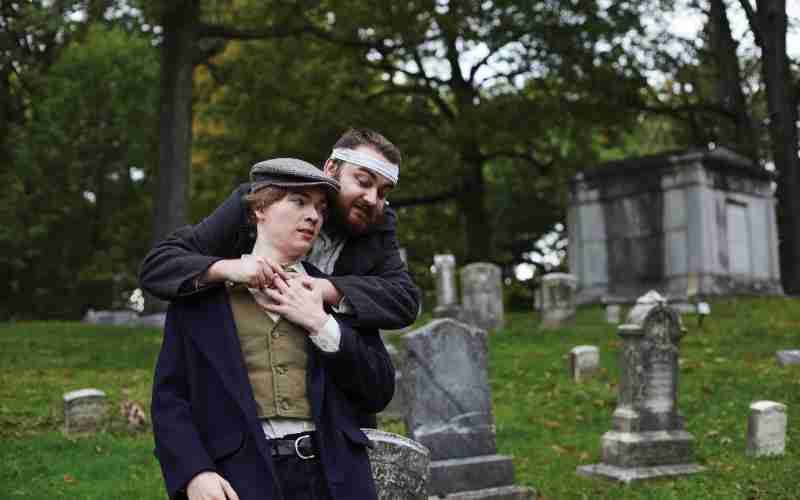A story that opens in a graveyard on Christmas Eve seems perfect for the season.
That’s certainly what Lauren Nichols, artistic director for all for One productions, thinks. Which is why the theater company is staging an adaptation of Charles Dickens’ Great Expectations.
Whatzup features writer Thom Hofrichter interviewed Nichols via email, and her responses created a compelling Q-and-A story, reproduced below with light editing:
Tom Hofrichter: Is staging adaptations of novels the theater’s mission or a personal preference?
Lauren Nichols: Both. As a voracious lifelong reader, I am especially partial to 19th century British literature. And as all for One began to develop our distinctive voice, we chose early on not to do “chestnuts” of theater. We wanted to venture into less traveled territory. Adaptations of novels allow us to do unfamiliar plays that also have name recognition.
Our culture is becoming increasingly illiterate with less and less appreciation for Western civilization. Also, Western literature is overwhelmingly Christian in its worldview. Hence, adaptations of great literature (which we produce once or twice a season) have both an educational aspect — one of our core values — and invariably contain thought-provoking themes which are overtly or subtly biblical.
TH: How does this production fulfill your mission, “impact our culture for God through the arts”?
LN: The show’s protagonist, Pip, is on a journey to discover his identity. At first, he equates value with money and class, and looks down on his family and childhood. The noblest characters in the story turn out to be those whom Pip originally despises as crude and uncultivated. He learns graces like truth, kindness, generosity, and integrity have little to do with class and everything to do with humans being made in the image of God.
Our mainstage work always includes a conscious effort to impact our culture, as we invite a diverse group of creative people to use their gifts for God’s glory. We never know exactly how a particular story will impact the mind and heart of an individual — whether actor, crew, or audience — but we prayerfully expect the Holy Spirit to be at work.
TH: Why is now a good time to stage this show?
LN: Pip is caught up in an envious and destructive “if only” thought pattern which is as old as humanity. He allows himself to drift along toward the future he assumes is promised to him through his “expectations” and meanwhile takes no positive initiative to do anything good with his life. When he begins to see how his choices are harming others, and starts to think of others before himself, he is finally on the road to a life of integrity.
Our 21st century therapeutic culture is perhaps the most self-centered and isolated of all time, for a variety of reasons, both technological and philosophical. Stories of a world in which people need one another desperately are healthy for pulling us out of our own headspace.
TH: The show is written for seven actors to play 40 characters. What challenges and opportunities does that create?
LN: It’s actually a cast of eight now. I added another man at auditions. I had two roles to cast and I had three talented gentlemen. Dividing the roles between three actors was ideal. And having an extra actor was quite beneficial, since the cast is kept busy, between playing named characters, doing narration, and moving furniture and walls.
When not in a scene, they are still present as observers. The challenge of creating multiple roles is one which the actors embrace with delight.
TH: How do the sets, costumes, lights, and sound designs facilitate staging this production?
LN: As context, we chose to be a late 19th century theater company, in their own theatrical space, looking for their next script. The actors make several suggestions to one another before landing on Great Expectations, but once they read the opening lines of the book, they can’t stop telling the story.
We’ve chosen to use everything visible on the stage, so that the staging is minimalist and stylized. The base costume is late Victorian, and they put on a single costume piece to transform into other characters. Each actor has a primary character whose costume is the most elaborate. Miss Havisham in her wedding dress is the prime example.
Since the staging is made up of “found” items, we did quite a bit of brainstorming, improvising, and experimenting to come up with props and scenery, especially Miss Havisham’s cake and the carriage at the end of Act One. I always prefer a highly collaborative environment, so I did not do highly detailed blocking in advance. Once we had established the context for the play and the “rules” we would follow, things began to fall into place nicely.
Sound effects in the early scenes will be performed by the actors, although as the audience is drawn into the story there are some recorded effects, especially in Act 3, which has several challenging climactic scenes (including a fire and a boat accident).
The music is primarily British folk music. A tune called “Botany Bay” (about an Australian penal colony) provides the main theme. Several versions of “God Rest Ye Merry, Gentlemen” are also used. Actors sing from time to time, with a four-part arrangement of “The Harmonious Blacksmith” being a highlight, as is a comedic rendition of “The Twelve Days of Christmas.”
Our lighting, designed by Luke Holliger, does much of the heavy lifting for setting scene and mood. As for the set, there are movable walls which define the space. So, actors must not only remember their lines, but also when and where to move the set. Fortunately, this year we moved into our new rehearsal space. No longer having to stash everything out of the way in a borrowed space is such a relief. This move has been a long, long time coming! And now it is an ongoing joy.
TH: Why is it important not to miss this production?
LN: This play neatly straddles the gap between Halloween and Christmas — how many shows open in a graveyard on Christmas eve? I hope Fort Wayne theater-goers will take this opportunity to enjoy first-rate acting in a classic whose warmth and humor will jump-start their holiday spirit.



